Our 6 Stages to Phonics Mastery!
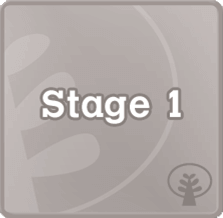
ages 4 to 5
28 lessons
The course provides a simple introduction to our main phonics program for younger children. Stage 1 covers every letter of the alphabet and all the primary sounds of the alphabet with a special emphasis on the short vowels. Whilst learning the alphabet phonemes, the children will focus on simple blending and segmenting. Early writing skills are developed using pre-cursive letters.
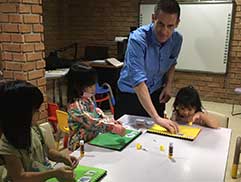
Structured activities to develop reading, writing, listening and speaking skills.

Sound review activities like finding the correct sounds.
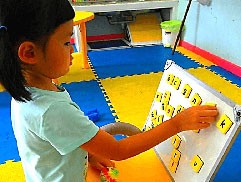
New sound activities
such as digging for /d/-dinosaur bones.
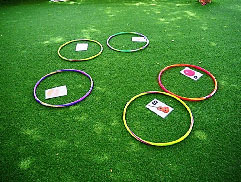
Vocabulary activities reinforce learning. Students will play hula hoop jumping, for example.
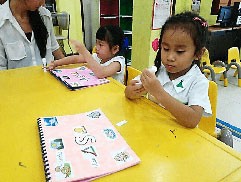
‘Get up and Go’ games
help with children’s understanding of sounds and their relation to target vocabulary.
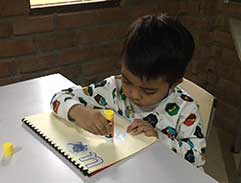
Big Book activity
Students will make a giant sound book with pictures and vocabulary for each sound.
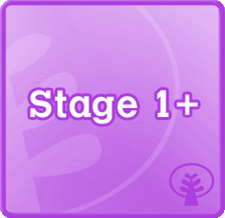
ages 5 to 6
22 lessons
The first half of the course concentrates on using each letter sound to build and decode simple words. The second half of the course puts these skills into practice by reading decodable phonics books by Oxford Reading Tree. Early writing skills are developed and children are taught using pre-cursive letters.
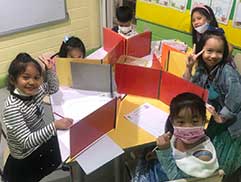
Stage 1+
This is where students start to put all their phonics knowledge into practice. The first half of the course concentrates on using each letter sound to build and decode simple words. The second half puts these skills into practice by reading.
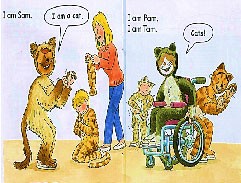
Sentence Reading
Students will learn to blend sounds into words, like blending /t/-/a/-/m/ – Tam.
Decodable phonics reading books help children improve their vocabulary and comprehension from an early age.
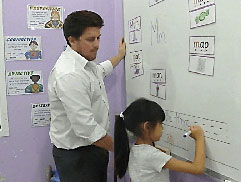
Letter Formation
Students will engage in writing activities, such as on a whiteboard, to learn to write letters in pre-cursive penmanship in preparation for cursive writing.
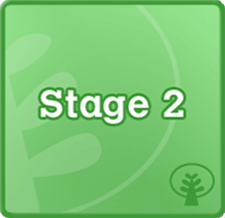
ages 5 to 6
18 lessons
Stage 2 continues the students’ use of blending and segmenting techniques to help them decode and read simple 3, 4 and 5 letter phonetic words. This course uses the harder sounds from the alphabet and introduces the use of digraphs (one sound represented by two letters such as /sh/ as in fish). Throughout the second half of this course children build on their sound knowledge and increase their vocabulary and comprehension skills by reading decodable phonics books by Oxford Reading Tree.
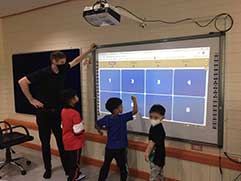
Stage 2 follows a similar structure to Stage 1+ but moves onto more complicated consonants and the basic digraph blends (sounds with 2 letters) /sh/ as in fish.

Structured activities to develop reading, writing, listening and speaking skills. Focus on the more difficult alphabet sounds and introducing diagraphs.
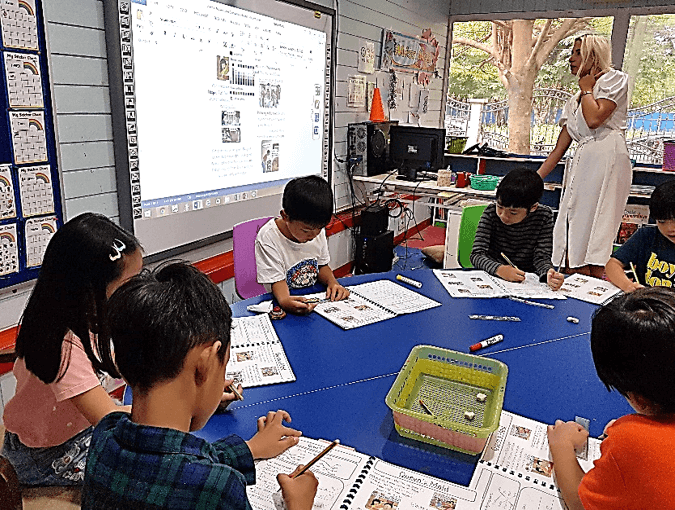
Letter formation workbook activities will have students will practice writing and vocabulary.
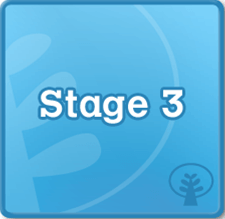
ages 6 to 7
30 lessons
Stage 3 introduces the student to more complex phonetic sounds with 2 and 3 letters. Blending and segmenting is used to decode words for reading and spelling. Consonant blends are also taught and practiced to help the students read and speak fluently. There is a stronger focus on stories in the course with a new story introduced every other week. This course also introduces reading comprehension skills. High frequency words are also taught and practiced to help the students’ fluency when reading. Cursive writing skills are developed and children are taught to write all sounds cursively.

Stage 3 teaches long vowels and alternate spellings for digraphs. This course differs in that a decodable book is read every other lesson to help reinforce the target sound.
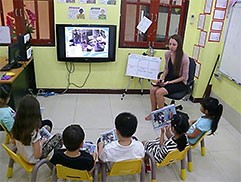
Structured activities to develop reading, writing, listening and speaking skills.
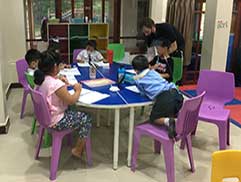
Decodable stories
highlight more target digraphs – 2 letter sounds; e.g. the /oi/ in oil say /oy/
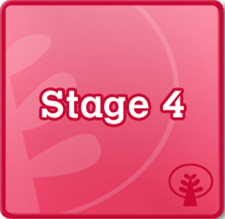
ages 6 to 7
26 lessons
Stage 4 is the final step in our phonics program before starting Macmillan English. This course focuses on teaching the students the main long vowel alternatives so the students can read almost any decodable text. A new story is introduced every two weeks to help practice the alternatives in a natural way. Consonant blends and high frequency words are also taught to make sure the students are reading and speaking fluently. Independent reading comprehension is also a key component of this course. Cursive writing skills are developed and children are expected to write cursively all of the time.
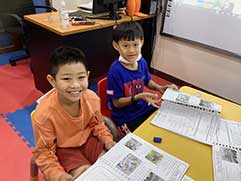
Stage 4 follows a similar structure to Stage 3 however more complex alternate spellings of long vowels and digraphs are taught alongside a decodable reader every other lesson.
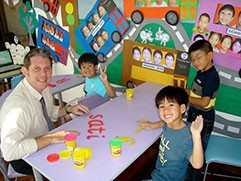
Structured activities to develop reading, writing, listening and speaking skills.
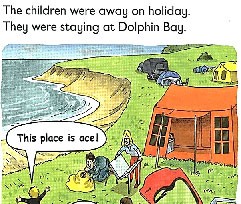
Decodable readers contain a variety of alternate spellings of phonemes. Students learn, for example, that /ai/ can be spelt /ai/ (rain), /ay/ (stay), and /a_e/ as in make.
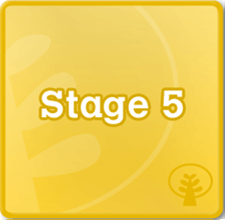
ages 6 to 7
26 lessons
Stage 5 teaches the final alternative phonics spellings and as a final phonics review of the whole course. After each lesson the students are given phonics readers to take home to help them practice their reading independently. Stage 5 serves as a final phonics review plus introduces the most advanced alternate spellings for the 49 phonemes. Phonics readers are given to the students to take home for independent reading practice.
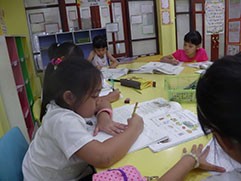
Stage 5 teaches the final alternative phonics spellings and as a final phonics review of the whole course.
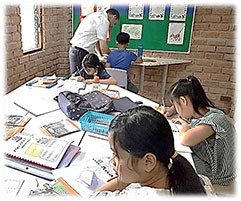
Alternative Spellings. Students learn that the /ear/ in gear can also be spelt as /eer/ as in steer, /ere/ as in here and even as /ier/ as in pier!

Phonics readers are given to the students after each lesson to take home to help them practice their reading independently.
6 Stages to Phonics Mastery!

ages 4 to 5
28 lessons
The course provides a simple introduction to our main phonics program for younger children. Stage 1 covers every letter of the alphabet and all the primary sounds of the alphabet with a special emphasis on the short vowels. Whilst learning the alphabet phonemes, the children will focus on simple blending and segmenting. Early writing skills are developed using pre-cursive letters.

Structured activities to develop reading, writing, listening and speaking skills.

Sound review activities like finding the correct sounds.

New sound activities such as digging for /d/-dinosaur bones.

‘Get up and Go’ games help with children’s understanding of sounds and their relation to target vocabulary.

Vocabulary activities reinforce learning. Students will play hula hoop jumping, for example.

Big Book activity
Students will make a giant sound book with pictures and vocabulary for each sound.

Structured activities to develop reading, writing, listening and speaking skills.

Sound review activities like finding the correct sounds.

New sound activities
such as digging for /d/-dinosaur bones.

‘Get up and Go’ games help with children’s understanding of sounds and their relation to target vocabulary.

Vocabulary activities reinforce learning. Students will play hula hoop jumping, for example.

Big Book activity
Students will make a giant sound book with pictures and vocabulary for each sound.

ages 5 to 6
22 lessons
The first half of the course concentrates on using each letter sound to build and decode simple words. The second half of the course puts these skills into practice by reading decodable phonics books by Oxford Reading Tree. Early writing skills are developed and children are taught using pre-cursive letters.

Stage 1+
This is where students start to put all their phonics knowledge into practice. The first half of the course concentrates on using each letter sound to build and decode simple words. The second half puts these skills into practice by reading.

Sentence Reading
Students will learn to blend sounds into words, like blending /t/-/a/-/m/ – Tam.
Decodable phonics reading books help children improve their vocabulary and comprehension from an early age.

Letter Formation
Students will engage in writing activities, such as on a whiteboard, to learn to write letters in pre-cursive penmanship in preparation for cursive writing.

Stage 1+
This is where students start to put all their phonics knowledge into practice. The first half of the course concentrates on using each letter sound to build and decode simple words. The second half puts these skills into practice by reading.

Sentence Reading
Students will learn to blend sounds into words, like blending /t/-/a/-/m/ – Tam.
Decodable phonics reading books help children improve their vocabulary and comprehension from an early age.

Letter Formation
Students will engage in writing activities, such as on a whiteboard, to learn to write letters in pre-cursive penmanship in preparation for cursive writing.

ages 5 to 6
18 lessons
Stage 2 continues the students’ use of blending and segmenting techniques to help them decode and read simple 3, 4 and 5 letter phonetic words. This course uses the harder sounds from the alphabet and introduces the use of digraphs (one sound represented by two letters such as /sh/ as in fish). Throughout the second half of this course children build on their sound knowledge and increase their vocabulary and comprehension skills by reading decodable phonics books by Oxford Reading Tree.

Stage 2 follows a similar structure to Stage 1+ but moves onto more complicated consonants and the basic digraph blends (sounds with 2 letters) /sh/ as in fish.

Structured activities to develop reading, writing, listening and speaking skills. Focus on the more difficult alphabet sounds and introducing diagraphs.

Letter formation workbook activities will have students will practice writing and vocabulary.

Stage 2 follows a similar structure to Stage 1+ but moves onto more complicated consonants and the basic digraph blends (sounds with 2 letters) /sh/ as in fish.

Structured activities to develop reading, writing, listening and speaking skills. Focus on the more difficult alphabet sounds and introducing diagraphs.

Letter formation workbook activities will have students will practice writing and vocabulary.

ages 6 to 7
30 lessons
Stage 3 introduces the student to more complex phonetic sounds with 2 and 3 letters. Blending and segmenting is used to decode words for reading and spelling. Consonant blends are also taught and practiced to help the students read and speak fluently. There is a stronger focus on stories in the course with a new story introduced every other week. This course also introduces reading comprehension skills. High frequency words are also taught and practiced to help the students’ fluency when reading. Cursive writing skills are developed and children are taught to write all sounds cursively.

Stage 3 teaches long vowels and alternate spellings for digraphs. This course differs in that a decodable book is read every other lesson to help reinforce the target sound.

Structured activities to develop reading, writing, listening and speaking skills.

Decodable stories highlight more target digraphs – 2 letter sounds; e.g. the /oi/ in oil say /oy/

Stage 3 teaches long vowels and alternate spellings for digraphs. This course differs in that a decodable book is read every other lesson to help reinforce the target sound.

Structured activities to develop reading, writing, listening and speaking skills.

Decodable stories
highlight more target digraphs – 2 letter sounds; e.g. the /oi/ in oil say /oy/

ages 6 to 7
26 lessons
Stage 4 is the final step in our phonics program before starting Macmillan English. This course focuses on teaching the students the main long vowel alternatives so the students can read almost any decodable text. A new story is introduced every two weeks to help practice the alternatives in a natural way. Consonant blends and high frequency words are also taught to make sure the students are reading and speaking fluently. Independent reading comprehension is also a key component of this course. Cursive writing skills are developed and children are expected to write cursively all of the time.

Stage 4 follows a similar structure to Stage 3 however more complex alternate spellings of long vowels and digraphs are taught alongside a decodable reader every other lesson.

Structured activities to develop reading, writing, listening and speaking skills.

Decodable readers contain a variety of alternate spellings of phonemes. Students learn, for example, that /ai/ can be spelt /ai/ (rain), /ay/ (stay), and /a_e/ as in make.

Stage 4 follows a similar structure to Stage 3 however more complex alternate spellings of long vowels and digraphs are taught alongside a decodable reader every other lesson.

Structured activities to develop reading, writing, listening and speaking skills.

Decodable readers contain a variety of alternate spellings of phonemes. Students learn, for example, that /ai/ can be spelt /ai/ (rain), /ay/ (stay), and /a_e/ as in make.

ages 6 to 7
26 lessons
Stage 5 teaches the final alternative phonics spellings and as a final phonics review of the whole course. After each lesson the students are given phonics readers to take home to help them practice their reading independently. Stage 5 serves as a final phonics review plus introduces the most advanced alternate spellings for the 49 phonemes. Phonics readers are given to the students to take home for independent reading practice.

Stage 5 teaches the final alternative phonics spellings and as a final phonics review of the whole course.

Alternative Spellings. Students learn that the /ear/ in gear can also be spelt as /eer/ as in steer, /ere/ as in here and even as /ier/ as in pier!

Phonics readers are given to the students after each lesson to take home to help them practice their reading independently.

Stage 5 teaches the final alternative phonics spellings and as a final phonics review of the whole course.

Alternative Spellings. Students learn that the /ear/ in gear can also be spelt as /eer/ as in steer, /ere/ as in here and even as /ier/ as in pier!

Phonics readers are given to the students after each lesson to take home to help them practice their reading independently.